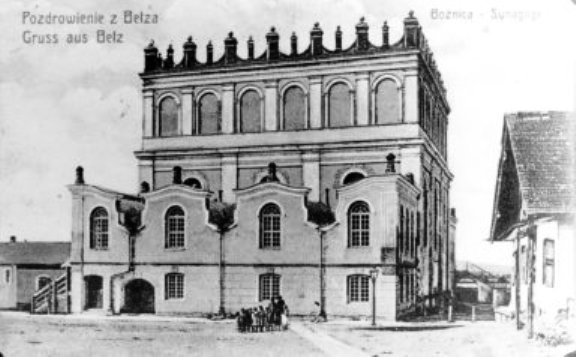|
Hasidic Judaism In Poland
Hasidic Judaism in Poland is the history of Hasidic Judaism and Hasidic philosophy in Poland. Hasidic Judaism in Poland began with Elimelech Weisblum of Lizhensk (LeŇľajsk) (1717-1787) and to a lesser extent Shmelke Horowitz of Nikolsburg (Mikulov) (1726-1778). Both men were leading disciples of Dov Ber of Mezeritch (Medzhybizh) (c. 1704‚Äď1772), who in part was the successor to the Baal Shem Tov (c. 1698‚Äď1760) who founded Hasidic Judaism in Western Ukraine. Today, a sizable portion of contemporary Hasidic Judaism and Hasidic dynasties trace their genealogical and ideological origin to Polish Hasidism. Noam Elimelech While Reb Shmelke of Nikolsburg was an influential figure from which the Nikolsburg Hasidic dynasty descends. It was Reb Elimelech of Lizhensk from which Polish Hasidism finds it truest origins. In his seminal work, "Noam Elimelech", Reb Elimelech of Lizhensk laid down the ideological foundation for Polish Hasidism, chiefly the doctrine of popular tzaddikism, w ... [...More Info...] [...Related Items...] OR: [Wikipedia] [Google] [Baidu] |
Hasidic Judaism
Hasidism, sometimes spelled Chassidism, and also known as Hasidic Judaism (Ashkenazi Hebrew: ◊ó◊°◊ô◊ď◊ē◊™ ''Šł§ńÉsńędus'', ; originally, "piety"), is a Judaism, Jewish religious group that arose as a spiritual revival movement in the territory of contemporary Western Ukraine during the 18th century, and spread rapidly throughout Eastern Europe. Today, most affiliates reside in Israel and the United States. Israel Ben Eliezer, the "Baal Shem Tov", is regarded as its founding father, and his disciples developed and disseminated it. Present-day Hasidism is a sub-group within Haredi Judaism and is noted for its religious conservatism and social seclusion. Its members adhere closely both to Orthodox Judaism, Orthodox Jewish practice ‚Äď with the movement's own unique emphases ‚Äď and the traditions of Eastern European Jews. Many of the latter, including various special styles of dress and the use of the Yiddish language, are nowadays associated almost exclusively with Hasidism. Hasi ... [...More Info...] [...Related Items...] OR: [Wikipedia] [Google] [Baidu] |
Yaakov Yitzchak Of Lublin
Yaakov Yitzchak HaLevi Horowitz ( he, ◊ô◊Ę◊ß◊Ď ◊ô◊¶◊ó◊ß ◊Ē◊ú◊ē◊ô ◊Ē◊ē◊®◊ē◊Ď◊ô◊•), known as "the Seer of Lublin" (), ''ha-Chozeh MiLublin''; (c. 1745 - August 15, 1815) was a Hasidic rebbe from Poland. "Rabbi Yaacov Yitzchak, the Chozeh of Lublin, is one of the truly beloved figures of Chassidism. He merited the title of Chozeh, which means seer or visionary ..." A leading figure in the early Hasidic movement, he became known as the "seer" or "visionary" due to his purported ability to gaze across great distance by supernatural means. He was a disciple of the Maggid of Mezritch. He continued his studies under Shmelke of Nilkolsburg and Elimelech of Lizhensk. He lived for a while in Lantzut before moving to Lublin. After Horowitz moved to Lublin, thousands of Hasidim flocked to learn from him. Among his disciples were such Hasidic luminaries as Yaakov Yitzchak Rabinowicz ("the Holy Jew"), Simcha Bunim of Peshischa, Meir of Apta, David of Lelov, Moshe Teitelbaum, Tzvi Elimelech ... [...More Info...] [...Related Items...] OR: [Wikipedia] [Google] [Baidu] |
Belz
Belz ( uk, –Ď–Ķ–Ľ–∑; pl, BeŇāz; yi, ◊Ď◊Ę◊ú◊Ė ') is a small city in Lviv Oblast of Western Ukraine, near the border with Poland, located between the Solokiya river (a tributary of the Bug River) and the Richytsia stream. Belz hosts the administration of Belz urban hromada, one of the hromadas of Ukraine. Its population is approximately . Origin of name There are a few theories as to the origin of the name: * Celtic languages, Celtic ‚Äď ''belz'' (water) or ''pelz'' (stream), * German language, German ‚Äď ' (fur, furry) * Old Slavic language, Old Slavic and the Boykos, Boyko language ‚Äď ¬ę–Ī–Ķ–Ľ–∑¬Ľ or ¬ę–Ī–Ķ–≤–∑¬Ľ (muddy place), * Old East Slavic ‚Äď ¬ę–Ī—ä–Ľ–ł–∑—ƬĽ (white place, a glade in the midst of dark woods). The name occurs only in two other places, the first being a Celtic area in antiquity, and the second one being derived from its Romanian name: * ''Belz, Morbihan, Belz'' (department Morbihan), Brittany, France * ''BńÉl»õi'' (/''Beljcy'', also known in Yiddish as ... [...More Info...] [...Related Items...] OR: [Wikipedia] [Google] [Baidu] |
Sholom Rokeach
Sholom Rokeach (1781 ‚Äď September 10, 1855), also known as the ''Sar Sholom'' ( he, ◊©◊® ◊©◊ú◊ē◊Ě, "Angel of Peace"), was the first Belzer Rebbe. To Belzer Hasidim, he is known as "Der Ershter Rov" (the first rabbi), but in the city of Belz itself he was called "Der Alter Rov" (the old rabbi) in deference to the Bach, who presided as rabbi of Belz in the sixteenth century. Biography His father was Rabbi Eleazar Rokeach, one of the sages of the kloyz of Brody. The latter was the grandson of Rabbi Eleazar, author of ''Maaseh Rokeach'', rabbi of Brody until 1736, then Chief Rabbi of Amsterdam. His mother was Rebbetzin Rivka Henna Ramraz. After Rabbi Eleazar died at the age of 32, Rivka Henna lived in Brody with her five orphaned children. She sent her son Sholom, around 11 years old at the time, to be raised by her brother, Rabbi Yissachar Dov Ramraz, rabbi of Skohl, then in Galicia. Later on, he married Rabbi Yissachar Dov's daughter, Malka (1780 ‚Äď 23 August 1853). They had f ... [...More Info...] [...Related Items...] OR: [Wikipedia] [Google] [Baidu] |
Satmar (Hasidic Dynasty)
Satmar (Yiddish: ◊°◊ź÷∑◊ė◊ě◊ź÷∑◊®, Hebrew: ◊°◊ź◊ė◊ě◊®) is a Hasidic group founded in 1905 by Grand Rebbe Joel Teitelbaum, in the city of Szatm√°rn√©meti, Hungary (now Satu Mare in Romania). The group is an offshoot of the Sighet Hasidic dynasty. Following World War II, it was re-established in New York. Satmar is the largest Hasidic dynasty in the world, with some 26,000 households. It is characterized by extreme conservatism, complete rejection of modern culture, and fierce anti-Zionism. Satmar sponsors a comprehensive education and media system in Yiddish, and its members use Yiddish as a primary language. The sect also sponsors and leads the Central Rabbinical Congress, which serves as an umbrella organization for other very conservative, anti-Zionist, and mostly Hungarian-descended ultra-Orthodox communities. After Joel Teitelbaum's death in 1979, he was succeeded by his nephew, Moshe Teitelbaum. Since the latter's death in 2006, the dynasty is split between his two sons, ... [...More Info...] [...Related Items...] OR: [Wikipedia] [Google] [Baidu] |
Siget (Hasidic Dynasty)
Siget or Ujhel-Siget or Sighet Hasidism, or Sigter Hasidim, is a movement of Hungarian Haredi Jews who adhere to Hasidism, and who are referred to as ''Sigeter Hasidim''. Sighet Hasidism originated in the town of M√°ramarossziget, Hungary ( yi, ◊°◊ô◊í◊Ę◊ė, now Sighetu Marma»õiei, Romania). Siget is the parent dynasty of the more famous Satmar Hasidic dynasty. Since 1980, the leadership of Siget and Satmar have been united in the person of the Admor of Satmar, though the two groups continue to operate separate synagogues and retain differences in certain customs. Founding Hasidism was brought to Hungary by Rabbi Moshe Teitelbaum of Ujhel (known as the "''Yismach Moshe''"), a disciple of the "Chozeh of Lublin", Rabbi Yaakov Yitzchak of Lublin. The Sighet Hasidic dynasty began with Rabbi Yekusiel Yehuda Teitelbaum (I) (1808‚Äď1883), his grandson. The town of Sighet was in need of a rabbi to lead the Beis Din and answer the Jewish towns-people's religious questions. Teitelbaum app ... [...More Info...] [...Related Items...] OR: [Wikipedia] [Google] [Baidu] |
Moshe Teitelbaum (Ujhel)
Moshe Teitelbaum (1759 ‚Äď 17 July 1841) (), also known as the Yismach Moshe, was the Rebbe of Ujhely (S√°toralja√ļjhely) in Hungary. According to Leopold L√∂w, he signed his name "Tamar", this being the Hebrew equivalent of Teitelbaum, which is the Yiddish for "date palm" (compare German "Dattelbaum"). An adherent of the Polish Hasidic rebbe Yaakov Yitzchak of Lublin as well as of Sholom Rokeach of Belz (Hasidic dynasty), Belz, Teitelbaum was instrumental in bringing Hasidic Judaism to Hungary. Though initially opposed to Hassidism, after his son-in-law introduced him to Jacob Isaac Horowitz, he soon became an adherent. Teitelbaum first served as a rabbi in PrzemyŇõl, and later in Ujhely, where he was called in 1808. In Ujhely he founded a Hassidic congregation which was independent of the Jews of Galicia, Galician leaders. In 1822 Teitelbaum was suspected of having supplied amulets to certain Jewish culprits who had been cast into prison for libel, in order to assist them in ... [...More Info...] [...Related Items...] OR: [Wikipedia] [Google] [Baidu] |
Autocratic
Autocracy is a system of government in which absolute power over a state is concentrated in the hands of one person, whose decisions are subject neither to external legal restraints nor to regularized mechanisms of popular control (except perhaps for the implicit threat of a coup d'√©tat or other forms of rebellion). In earlier times, the term ''autocrat'' was coined as a favorable description of a ruler, having some connection to the concept of "lack of conflicts of interests" as well as an indication of grandeur and power. This use of the term continued into modern times, as the Russian Emperor was styled "Autocrat of all the Russias" as late as the early 20th century. In the 19th century, Eastern and Central Europe were under autocratic monarchies within the territories of which lived diverse peoples. Autocracy is the most common and durable regime type since the emergence of the state. History and etymology Autocracy comes from the Ancient Greek ''autos'' (Greek: őĪŠĹźŌ ... [...More Info...] [...Related Items...] OR: [Wikipedia] [Google] [Baidu] |
Lublin
Lublin is the ninth-largest city in Poland and the second-largest city of historical Lesser Poland. It is the capital and the center of Lublin Voivodeship with a population of 336,339 (December 2021). Lublin is the largest Polish city east of the Vistula River and is about to the southeast of Warsaw by road. One of the events that greatly contributed to the city's development was the Polish-Lithuanian Union of Krewo in 1385. Lublin thrived as a centre of trade and commerce due to its strategic location on the route between Vilnius and Krak√≥w; the inhabitants had the privilege of free trade in the Grand Duchy of Lithuania. The Lublin Parliament session of 1569 led to the creation of a real union between the Crown of the Kingdom of Poland and the Grand Duchy of Lithuania, thus creating the Polish‚ÄďLithuanian Commonwealth. Lublin witnessed the early stages of Reformation in the 16th century. A Calvinist congregation was founded and groups of radical Arians appeared in the city ... [...More Info...] [...Related Items...] OR: [Wikipedia] [Google] [Baidu] |
Czechówka, Lesser Poland Voivodeship
Czech√≥wka is a village in the administrative district of Gmina Siepraw, within MyŇõlenice County, Lesser Poland Voivodeship, in southern Poland. It lies approximately south-east of Siepraw, north-east of MyŇõlenice, and south of the regional capital Krak√≥w Krak√≥w (), or Cracow, is the second-largest and one of the oldest cities in Poland. Situated on the Vistula River in Lesser Poland Voivodeship, the city dates back to the seventh century. Krak√≥w was the official capital of Poland until 1596 .... References Villages in MyŇõlenice County {{MyŇõlenice-geo-stub ... [...More Info...] [...Related Items...] OR: [Wikipedia] [Google] [Baidu] |
ŇĀaŇĄcut
ŇĀaŇĄcut (, approximately "wine-suit"; yi, ◊ú◊ź÷∑◊†◊¶◊ē◊ė, Lantzut; uk, –õ–įŐĀ–Ĺ—Ć—Ü—É—ā, L√°n Ļtsut; german: Landshut) is a town in south-eastern Poland, with 18,004 inhabitants, as of 2 June 2009. Situated in the Subcarpathian Voivodeship (since 1999), it is the capital of ŇĀaŇĄcut County. History Archeological investigations carried out in the region of ŇĀaŇĄcut confirm the existence of human settlements from about 4000 years B.C. The first owner of the town was Otton (''z Pilczy'') Pilecki, who was given the ŇĀaŇĄcut estate by the Polish king, Casimir III the Great, in 1349, as a reward for his service. At the same time, the king also granted ŇĀaŇĄcut its city rights according to Magdeburg law. In 1381 ŇĀaŇĄcut was officially named a ‚Äėtown‚Äô for the first time, by Otton Pilecki, in the foundation charter of the town. ŇĀaŇĄcut remained under the ownership of the Pilecki family up to 1586. The city was then owned consecutively by aristocratic Polish families of Stadnic ... [...More Info...] [...Related Items...] OR: [Wikipedia] [Google] [Baidu] |


.jpg)



